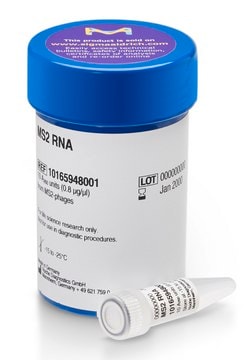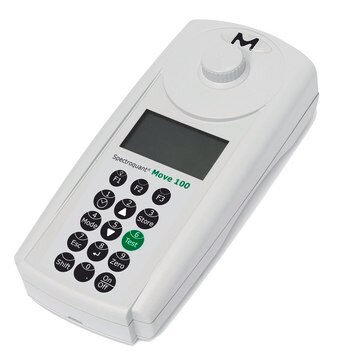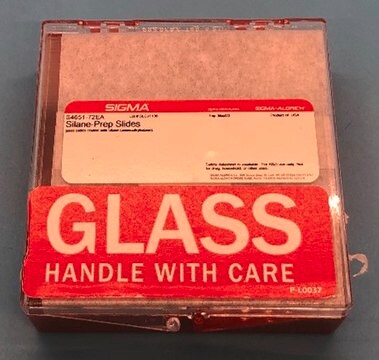D3654
Lambda Phage DNA, Non-methylated from Escherichia coli host strain GM119 (rm-,dam-,dcm-)
solution
Autenticatiper visualizzare i prezzi riservati alla tua organizzazione & contrattuali
About This Item
Prodotti consigliati
Grado
Molecular Biology
for molecular biology
Stato
solution
PM
31.5 × 103 kDa
48 kb
Compatibilità
suitable for substrate for restriction endonucleases
Condizioni di spedizione
dry ice
Temperatura di conservazione
−20°C
Cerchi prodotti simili? Visita Guida al confronto tra prodotti
Specificità
Unique Restriction Sites (Methylated DNA) are: Apa I,Nae I, Nar I, Nhe I, PaeR7 I, SnaB I, Xba I and Xho I.
Applicazioni
Lambda Phage DNA, Non-methylated from Escherichia coli host strain GM119 is suitable for use as a substrate for restriction enzymes. It was used as substrate for Prevotella ruminicola DNase activity studies. It was also used as a GC content standard in genome sequencing of 16S rDNA sequences of Cellvibrio japonicas.
Lambda Phage DNA, Non-methylated from Escherichia coli host strain GM119 (rm-,dam-,dcm-) has been used:
- to calibrate spectrophotometer (LKB) and HPLC (high performance liquid chromatography) method for determination of bacterial genomic DNA G+C content
- to amplify the λ; exonuclease gene by polymerase chain reaction (PCR)
- in DNase activities
The lambda phage has an icosahedral head and a long tail terminating in a single fiber. At both ends of the 5′ termini are complementary 12-nucleotide single strand sequences that contribute to the cohesive ends (cos region) of the DNA. The tail of the phage latches on the host outer membrane receptor and injects phage DNA into the cell. The phage converts the E. coli to a lysogenic state in which the phage functions are repressed and the phage genome may remain dormant (prophage) for a long time. This property is seen in bacteriophages that carry CII and CIII genes that are responsible for CI expression. Bacteriophages with CI mutation in the CI gene are able to maintain a lysogenic state at defined temperatures.
Infecting E. coli strain GM 119 with lambda C1857 strain creates E. coli lysogen cultures. The phage is released from E. coli cell pellets by lysing with a high salt buffer, pH 8.0. The crude mixture is passed through a series of enzymatic steps, multiple cesium gradients, and phage DNA is dialyzed against 1 mM Tris-HCl, pH 8.0, and 1 mM magnesium chloride. The DNA is finally extracted by phenol-chloroform solution.
Infecting E. coli strain GM 119 with lambda C1857 strain creates E. coli lysogen cultures. The phage is released from E. coli cell pellets by lysing with a high salt buffer, pH 8.0. The crude mixture is passed through a series of enzymatic steps, multiple cesium gradients, and phage DNA is dialyzed against 1 mM Tris-HCl, pH 8.0, and 1 mM magnesium chloride. The DNA is finally extracted by phenol-chloroform solution.
Stato fisico
Phage DNA is isolated from infected E. coli, passed through a series of enzymatic steps before final phenol-chloroform extraction. This non-methylated lambda DNA is completely digested by Bcl I, Cla I, Mbo I, Mbo II, Taq I or Xba I whereas methylated lambda DNA(product number D3779) is only partially cleaved. The unique restriction sites are Apa I,Nae I, Nar I, Nhe I, PaeR7 I, SnaB I, Xba I and Xho I.
Substrati
Non-methylated lambda DNA is completely digested by Bcl I, Cla I, Mbo I, Mbo II, Taq I or Xba I whereas methylated lambda DNA is only partially cleaved.
Prodotti correlati
N° Catalogo
Descrizione
Determinazione del prezzo
Codice della classe di stoccaggio
10 - Combustible liquids
Classe di pericolosità dell'acqua (WGK)
WGK 2
Punto d’infiammabilità (°F)
Not applicable
Punto d’infiammabilità (°C)
Not applicable
Dispositivi di protezione individuale
Eyeshields, Gloves, type ABEK (EN14387) respirator filter
Scegli una delle versioni più recenti:
Possiedi già questo prodotto?
I documenti relativi ai prodotti acquistati recentemente sono disponibili nell’Archivio dei documenti.
I clienti hanno visto anche
Janine G Borgaro et al.
Nucleic acids research, 41(7), 4198-4206 (2013-03-14)
In T4 bacteriophage, 5-hydroxymethylcytosine (5hmC) is incorporated into DNA during replication. In response, bacteria may have developed modification-dependent type IV restriction enzymes to defend the cell from T4-like infection. PvuRts1I was the first identified restriction enzyme to exhibit specificity toward
Distribution of restriction endonucleases among some entomopathogenic strains of Bacillus sphaericus
Zahner V and Priest FG
Letters in Applied Microbiology, 24, 483-487 (1997)
Reclassification of `Pseudomonas fluorescens subsp. cellulosa?NCIMB 10462 (Ueda et al. 1952) as Cellvibrio japonicus sp. nov. and revival of Cellvibrio vulgaris sp. nov., nom. rev. and Cellvibrio fulvus sp. nov., nom. rev.
Humphry D R, et al.
International Journal of Systematic and Evolutionary Microbiology, 53(2), 393-400 (2003)
Allosteric ring assembly and chemo-mechanical melting by the interaction between 5?-phosphate and lambda exonuclease
Yoo J and Lee G
Nucleic Acids Research, 43(22), 10861-10869 (2015)
David R Humphry et al.
International journal of systematic and evolutionary microbiology, 53(Pt 2), 393-400 (2003-04-25)
'Pseudomonas fluorescens subsp. cellulosa' NCIMB 10462 has been demonstrated by a polyphasic taxonomic approach to be a member of the genus Cellvibrio. 16S rDNA sequence analysis suggests that this is the only genus that could accept this specimen. The sequence
Il team dei nostri ricercatori vanta grande esperienza in tutte le aree della ricerca quali Life Science, scienza dei materiali, sintesi chimica, cromatografia, discipline analitiche, ecc..
Contatta l'Assistenza Tecnica.









